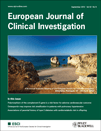Assessing nutritional status of acute intermittent porphyria patients
Abstract
Eur J Clin Invest 2012; 42 (9): 943–952
Background Acute intermittent porphyria (AIP) is a metabolic disease of haem synthesis, whose haem precursors may accumulate in the body. A well-balanced diet may prevent the symptoms, so that porphyric patients should be monitored closely during therapy for possible complications concerning any progression of acute porphyria. The aim was to evaluate the nutritional status of patients with AIP and to assess their compliance with nutritional recommendations, comparing the findings with a control group and assessing any possible nutritional deficiency.
Material and Methods Sixteen patients with AIP and a control group were evaluated by means of a lifestyle questionnaire, the Nutrition Screening Initiative checklist and a dietary questionnaire. The following diet quality indicators were calculated: animal and vegetal proteins, protein quality index, PUFA/SFA and MUFA + PUFA/SFA ratios, insoluble dietary fibre (DF)/total DF, soluble DF/total DF and insoluble DF/soluble DF ratios, thiamine, riboflavin and niacin density and the vitamin B6/protein ratio.
Statistical methods Differences in continuous variables were compared using the unpaired Student’s t-test and the chi-square test for nonparametric variables. The odds ratio (OR) of malnutrition was also used.
Results Our patients showed a low intake of carbohydrates, a high lipid intake and very high protein intake, and accompanied by an inadequate intake of zinc, folic acid and tocopherol, increasing the risk of malnutrition for energy, Ca, Fe, Mg, K, folic acid and tocopherols.
Conclusions The patients with AIP studied individually show an increased risk of malnutrition and, given the potential increase of oxidative stress in patients with porphyria, it is recommended that they should increase their intake of carbohydrates, minerals and antioxidant nutrients.




